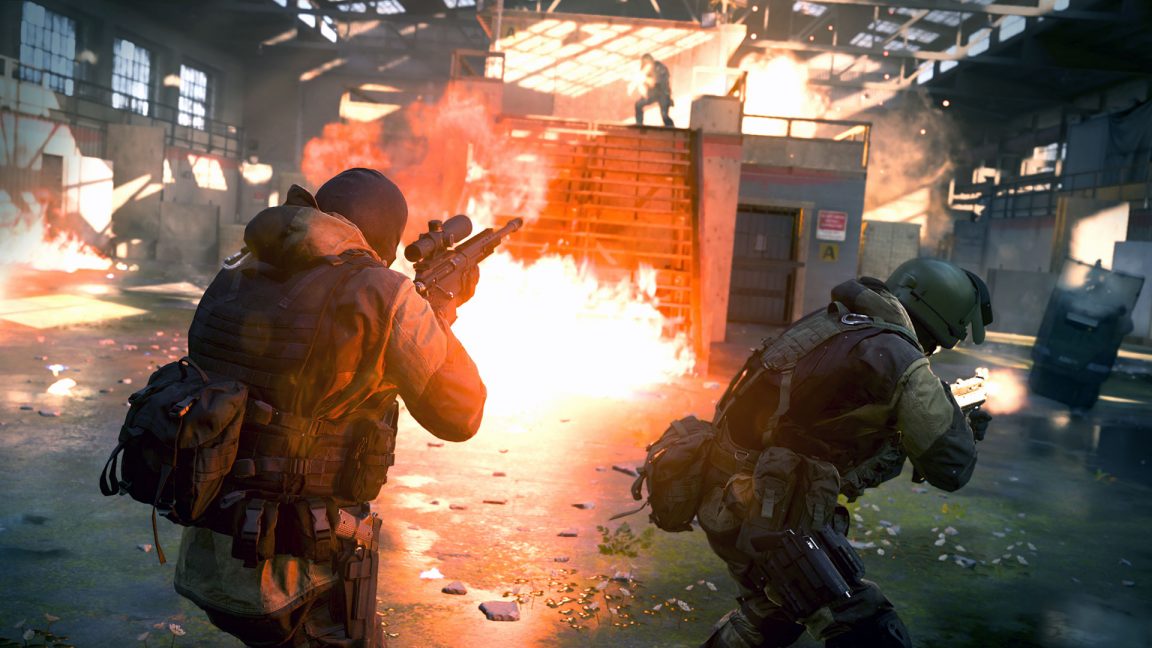The kill/death ratio is holding Call of Duty back
There’s a strange, hidden mode in Call of Duty: Modern Warfare. It starts when you boot up a game of Gunfight, settle into a firing position, and wait for an enemy that... never comes. Slowly, tentatively, you and your teammates emerge from cover and creep into the back half of the level to discover your opponents docile, uncannily still, pointing their guns into the middle distance. A network error, perhaps, or two friends AFK.
It would make sense to quit the match at this point, knowing the competition is already over. But this is when the new contest begins. At the beginning of each round, you and your teammates sprint at full pelt across the map - racing to splatter your lobotomised enemies against the scenery. There’s even a learning curve: make sure you’re carrying a lighter gun, and you’ll have the edge when it comes to speed.
It’s not fun, though - not really. It’s just what you do when you’re living in service to your kill/death ratio.
The k/d predates Call of Duty, but since the series became the dominant force in multiplayer shooting, the two have been inseparable. You can see the appeal of a simple calculation that determines roughly how good you are. In a chaotic game, it's long been useful for tracking personal improvement, or just for a little self-esteem boost.
But the metrics you value influence your behaviour, and in COD's newer modes, they’re not helping. It's very common for Gunfight players to drop out of a match early if the k/d tilts in the wrong direction. Given that the mode supports a maximum of three players on each side, a single drop-out wrecks the balance of power, effectively dooming one team to defeat.
In Warzone the effects are subtler, but pervasive. In theory, only one kill is required to defeat the other 149 players on the map: the very last one. Even pacifist runs are possible, if your final opponent gets unlucky with the gas or steps on someone else’s claymore. It’s a setup that lends itself perfectly to stealth - letting the fight unfold just outside your hidey-hole, and crawling on your belly to avoid detection. Ghosting is not only a valid approach to battle royale, but a deeply gratifying one.
In that context, your kill/death ratio shouldn’t matter - it’s peripheral to the objective, a method rather than the goal. Yet most teams clatter across the map hungry for firefights. And no wonder. While Warzone rewards you handsomely with XP simply for surviving into the top 20, the most powerful feedback comes with a kill. There’s not much more satisfying than the crack of an opponent’s armour, followed by that rush of yellow text: DOWNED. TEAM WIPED. Daily and weekly challenges push you to rack up kills with certain weapons, and unlockable executions encourage you to pursue downed enemies and hack them to death, triggering showy out-of-body animations.
In other words, while your k/d is rarely visible unless you seek it out, the ratio is alive and well in Warzone, steering players in the direction of hyper-aggressive playstyles. If you’ve ever watched a Quads match go sideways because of a three-way teamfight which could have been avoided, you might have that metric to thank. If Call Of Duty is going to make room for new playstyles, it’ll need to move on from the number that’s defined it for a decade.
There’s a darker concern, too. During the Vietnam War, without clear territorial gains, the American army relied on reported kills as a measure of success - a metric that drove the horrible body count of that conflict. Philip Caputo, the journalist and former marine, recounted its impact in his famous memoir, A Rumour of War.
“Our mission was not to win terrain or seize positions, but simply to kill,” he wrote. “To kill communists and as many of them as possible. Stack ‘em like cordwood. Victory was a high body count, defeat a low kill ratio, war a matter of arithmetic.”
That focus on kill count saw US troops report massacred women and children as ‘enemy combatants’ during the worst events of the war.
“The pressure on unit commanders to produce enemy corpses was intense, and they in turn communicated it to their troops,” Caputo wrote. “‘If it’s dead and Vietnamese, it’s VC,’ was our rule of thumb in the bush. It is not surprising, therefore, that some men acquired a contempt for human life and predilection for taking it.”
If Call of Duty is going back to Vietnam for this year’s Black Ops reboot - as rumours have suggested it will - then its developers ought to be wary of evoking kill counts without criticism. If that means leaving k/d ratios behind, then the series will only be better for it.












